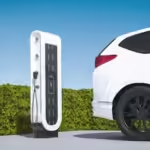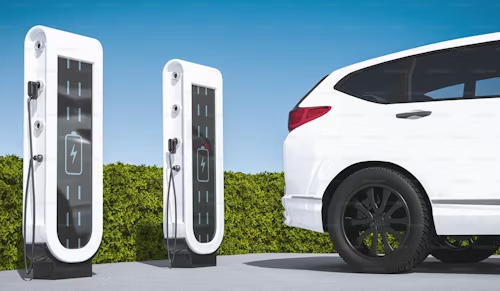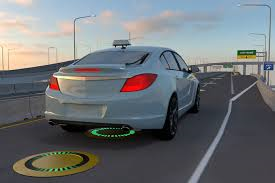EV electric vehicle, An electric vehicle (EV) is a type of vehicle that uses one or more electric motors for propulsion, powered by electricity stored in batteries or another energy storage device. Unlike traditional internal combustion engine vehicles that rely on fossil fuels, electric vehicles produce zero tailpipe emissions and offer a more environmentally friendly alternative for transportation. EVs come in various forms, ranging from fully electric vehicles that rely solely on electricity for propulsion to plug-in hybrid vehicles that combine electric propulsion with an internal combustion engine for extended range.
Components of an Electric Vehicle:
1. Electric Motor(s): The electric motor is the primary source of propulsion in an electric vehicle. It converts electrical energy from the battery into mechanical energy to drive the wheels.
2. Battery Pack: The battery pack stores electrical energy and provides power to the electric motor(s). It is typically made up of numerous lithium-ion battery cells arranged in modules or packs.
3. Power Electronics: Power electronics control the flow of electricity between the battery pack, electric motor(s), and other vehicle systems. They regulate power delivery, manage energy efficiency, and convert between AC and DC power as needed.
4. Charging System: The charging system allows the battery pack to be recharged from an external power source, such as a wall outlet or charging station. It includes components such as onboard chargers, charging ports, and charging cables.
5. Electric Vehicle Controller: The electric vehicle controller manages the operation of the electric motor(s), power electronics, and other vehicle systems. It coordinates power delivery, monitors vehicle performance, and ensures safe operation.
6. Regenerative Braking System: Regenerative braking captures energy during braking and converts it into electrical energy to recharge the battery pack. This improves energy efficiency and extends driving range.
READ ALSO: AeroMobil: Flying Cars,The Future 1 of Mobility Breaking

Types of Electric Vehicles:
1. Battery Electric Vehicle (BEV): A battery electric vehicle is powered solely by electricity stored in a battery pack. It does not have an internal combustion engine and produces zero tailpipe emissions. Examples of BEVs include the Tesla Model S, Nissan Leaf, and Chevrolet Bolt EV.
2. Plug-in Hybrid Electric Vehicle (PHEV): A plug-in hybrid electric vehicle combines an electric motor and a battery pack with an internal combustion engine. It can operate in electric-only mode for shorter trips, relying on the internal combustion engine for longer trips or when the battery is depleted. Examples of PHEVs include the Toyota Prius Prime, Chevrolet Volt (now discontinued), and BMW i3 with Range Extender.
3. Hybrid Electric Vehicle (HEV): A hybrid electric vehicle uses an internal combustion engine and an electric motor to drive the wheels. Unlike PHEVs, HEVs do not have a plug-in capability and rely on regenerative braking to recharge the battery. Examples of HEVs include the Toyota Prius, Honda Insight, and Ford Fusion Hybrid.
4. Fuel Cell Electric Vehicle (FCEV): A fuel cell electric vehicle uses hydrogen gas to produce electricity through a chemical reaction in a fuel cell stack. The electricity generated powers an electric motor, producing water vapor as the only emission. Examples of FCEVs include the Toyota Mirai and Hyundai Nexo.
Advantages of Electric Vehicles:
1. Zero Emissions: Electric vehicles produce zero tailpipe emissions, reducing air pollution and greenhouse gas emissions compared to traditional internal combustion engine vehicles.
2. Energy Efficiency: Electric motors are more efficient than internal combustion engines, converting a higher percentage of stored energy into mechanical energy for propulsion.
3. Lower Operating Costs: Electric vehicles have lower fuel and maintenance costs compared to gasoline or diesel vehicles. Electricity is often cheaper than gasoline or diesel fuel, and electric vehicles have fewer moving parts that require maintenance.
4. Quiet Operation: Electric vehicles are quieter than internal combustion engine vehicles, reducing noise pollution in urban areas and providing a more comfortable driving experience.
5. Regenerative Braking: Regenerative braking captures energy during braking and stores it in the battery pack, extending driving range and improving energy efficiency.
Disadvantages of Electric Vehicles:
1. Limited Range: Electric vehicles typically have a shorter driving range compared to traditional vehicles, especially in cold weather or when operating at highway speeds.
2. Long Charging Times: Charging an electric vehicle can take significantly longer than refueling a gasoline or diesel vehicle, especially with slower charging options like household outlets.
3. Charging Infrastructure: The availability of charging infrastructure for electric vehicles varies by region, which can limit the convenience and practicality of long-distance travel.
4. Upfront Cost: Electric vehicles tend to have higher upfront costs compared to traditional vehicles, primarily due to the cost of battery technology. However, this cost difference is decreasing as battery prices continue to fall.
5. Battery Degradation: The performance and capacity of electric vehicle batteries degrade over time, reducing driving range and requiring eventual replacement.
READ ALSO: HISTORY OF ELECTRIC VEHICLES { E.Vs }
EV electric vehicle
Origins and Manufacturers:
Electric vehicles have a long history dating back to the 19th century, but they gained renewed interest and popularity in the late 20th and early 21st centuries with advancements in battery technology and environmental concerns. Many automakers around the world produce electric vehicles, each with its own unique engineering and design features.
1. Tesla: Tesla is a pioneer in the electric vehicle industry, known for its innovative designs, long-range electric vehicles, and fast-charging infrastructure. The company produces models like the Model S, Model 3, Model X, and Model Y at its facilities in the United States.
2. Nissan: Nissan produces the Nissan Leaf, one of the best-selling electric vehicles globally, at various manufacturing plants worldwide, including Japan, the United States, and the United Kingdom.
3. Chevrolet: Chevrolet produces the Chevrolet Bolt EV, a compact electric vehicle with an affordable price and long-range capability, at its manufacturing facility in Michigan, United States.
4. BMW: BMW produces electric vehicles like the BMW i3 and BMW iX3 at its manufacturing plants in Germany and other locations worldwide.
5. Toyota: Toyota produces hybrid electric vehicles like the Toyota Prius and plug-in hybrid electric vehicles like the Toyota Prius Prime at manufacturing plants worldwide, including Japan, the United States, and China.
6. Hyundai / Kia: Hyundai and Kia produce electric vehicles like the Hyundai Kona Electric and Kia Niro EV at manufacturing plants in South Korea and other locations worldwide.
7. Volkswagen Group: Volkswagen Group produces electric vehicles like the Volkswagen ID.3 and ID.4, Audi e-tron, and Porsche Taycan at various manufacturing plants in Germany and other locations worldwide.
These are just a few examples of automakers producing electric vehicles. As demand for electric vehicles continues to grow and technology advances, more manufacturers are entering the market and expanding their electric vehicle offerings.












